First World War Books
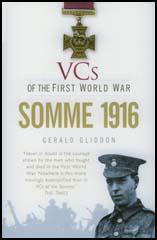
Title: VCs: Somme 1916
Author: Gerald Gliddon
Editor:
Publisher: History Press
Price: £9.99
Bookshop: Amazon
Spartacus Website: Victoria Cross
Category:
During the opening four months of the First World War no fewer than forty-six soldiers from the British and Commonwealth armies were awarded the Victoria Cross, Britain's highest award for gallantry. In a series of biographies, Gerald Gliddon examines the men and the dramatic events that led to the award of this most coveted of medals and explores the post-war experiences of those who survived. These men, ordinary soldiers from widely differing social backgrounds, acted with valour above and beyond the call of duty. Their stories and experiences offer a fresh perspective on the opening stages of the 'war to end wars'.
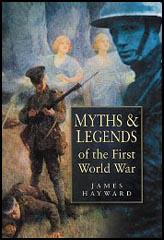
Title: Myths and Legends of the First World War
Author: James Hayward
Editor:
Publisher: History Press
Price: £8.99
Bookshop: Amazon
Spartacus Website: War Propaganda Bureau
Category:
During the First World War, a rich crop of legends sprouted from the battlefields and grew with such ferocity that many still excite controversy today. This book is the first to examine the roots of those stories and reveal the truth. Some myths remain well-known. Did an entire battalion of the Norfolk Regiment vanish without trace at Gallipoli in 1915? Did thousands of Russian troops actually pass through England with snow on their boots? In 1914, an acute spy mania gripped the British public, who imagined that the country was brimming with German spies. Xenophobia, denunciations and attacks on dachshunds were rampant. Amazingly, there was even talk of enemy aircraft dropping poisoned sweets to kill British children. Myths such as the Angel of Mons and the Comrade in White were more innocent creations. With no radio or television, rumours of disaster were rife, and the apparition of mystical guardian spirits gave hope to the civilian population at home. Other stories, such as the so-called Crucified Canadian, and the existence of a gruesome German corpse rendering factory, were more sinister. Yet in an age of new and startling technologies such as poison gas, submarine warfare and the tank, such tales appeared believable. Using a wide range of contemporary sources, James Hayward traces the story of each myth and examines the likely explanation. Supported by a selection of rare photographs and illustrations, the result is a refreshingly different perspective on the common 'mud and trenches' view of the First World War, shedding fascinating new light on many curious and unexplained wartime tales. James Hayward is an editor and historian with a particular interest in twentieth-century military and art history.
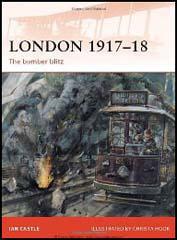
Title: London 1917-1918
Author: Ian Castle
Editor:
Publisher: Osprey
Price: £14.99
Bookshop: Amazon
Spartacus Website: Home Front
Category:
On a sunny May afternoon in 1917, the peace of an English seaside town was shattered when a flight of German Gotha bombers appeared without warning. Twenty-three Gothas had set out to attack London in this first bomber raid, but heavy cloud forced them to target Folkestone and the Shorncliffe army camp instead. It was the start of a new phase of the war aimed at destroying the morale of the British people. London's defences were quickly overhauled to face this new threat, providing the basis for Britain's defence during World War II. This book tells the story of the Gotha and the massive Staaken 'Giant' bomber raids against London.
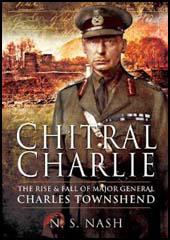
Title: Chitral Charlie
Author: N. S. Nash
Editor:
Publisher: Pen & Sword
Price: £14.99
Bookshop: Amazon
Spartacus Website: First World War Websites
Category:
Charles Townshend achieved international fame, as a captain, when he commanded the besieged garrison at Chitral (now Pakistan) in 1895. As a result, he became known as ‘Chitral Charlie’. Decorated by Queen Victoria and lionised by the British public, his passage up through the Army was assured and, in 1916, he was given command on 6th Indian Division and sent to Mesopotamia. Here he won a series of stunning victories as his ill-supported division swept all before it in a devastating advance up the River Tigris. He triumphed brilliantly at Kurna, Amara and Kut but then, against all the tenets of military common sense, he advanced up the River Tigris to take Baghdad. By now over-reached, he was confronted by a determined Turkish foe. His Division was depleted and exhausted. Townshend withdrew to Kut, where he was besieged and forced into a humiliating surrender. The mis-treatment of the British POWs by the Turks only added to Townshend’s shame. This fascinating and objective biography examines Townshend’s controversial conduct during and after the siege and assesses whether his dramatic fall from grace and popularity was fair.
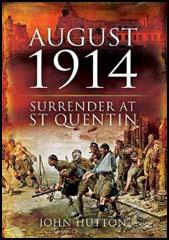
Title: August 1914
Author: John Hutton
Editor:
Publisher: Pen & Sword
Price: £24.95
Bookshop: Amazon
Spartacus Website: Chronology
Category:
The great retreat of the British Expeditionary Force from Mons in August 1914 is one of the most famous in military history, and it is justly celebrated. But not all the British soldiers who were forced back by the German offensive performed well. Two colonels, Elkington and Mainwaring, tried to surrender rather than fight on, and were disgraced. This is their story. It is one of the least glorious and most revealing episodes in the record of the British Army during the conflict on the Western Front. In this compelling account John Hutton shows, in graphic detail, the full confusion of the retreat, and the dire mental state to which brave men can be reduced by extreme stress, uncertainty and fatigue. But he also describes how Elkington redeemed himself. He joined the French Foreign Legion, fought gallantly, was severely wounded and was reinstated by King George V. His is one of the more remarkable stories to come out of the Great War, as is the story of the attempted surrender at St Quentin itself.
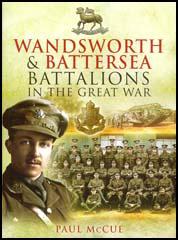
Title: Wandsworth & Battersea Battalions in the Great War
Author: Paul McCue
Editor:
Publisher: Pen & Sword
Price: £20.00
Bookshop: Amazon
Spartacus Website: Soldiers
Category:
In 1915 Lord Kitchener extended his famous “Your Country Needs You” recruitment campaign by appealing to the Mayors of the London Metropolitan Boroughs, urging each Mayor to raise a unit of local men for active service overseas. In south-west London, the response from two neighbouring boroughs, Wandsworth and Battersea, could not have been more different. In Wandsworth, Mayor Dawnay personally took up the challenge and soon recruited, for the East Surrey Regiment, double the number of men needed for an infantry battalion. In Battersea, however, there was initially no more than lukewarm interest, partly due to the local Territorial Force unit, the 23rd London Regiment, having expanded from one to three battalions thanks to thousands of earlier volunteers. But as Wandsworth’s efforts bore fruit, Battersea too pledged to raise a full infantry battalion. Mirroring the different political leanings of the two boroughs, Mayor Simmons pledged Battersea’s battalion to the Queen’s (Royal West Surrey) Regiment.

Title: Donald Dean
Author: Terry Crowdy
Editor:
Publisher: Pen & Sword
Price: £15.99
Bookshop: Amazon
Spartacus Website: War Heroes
Category:
The son of a Sittingbourne brick maker, Donald Dean lied about his age to enlist in 1915. Working his way up from Private to acting Captain in the Queen's Own Royal West Kent Regiment, Dean was severely wounded by machine gun fire at Passchendaele in 1917. Recovered from his wounds, Dean returned to France in 1918 where he won his VC near the city of Lens. Ordered to hold a captured and isolated trench, Dean fought off five German counterattacks, personally killing four Germans in hand-to-hand fighting. His citation read: „Throughout the period Lieutenant Dean inspired his command with his own contempt of danger, and all fought with the greatest bravery. He set an example of valorous leadership and devotion to duty of the very highest order.

Title: British and Commonwealth War Cemeteries
Author: Julie Summers
Editor:
Publisher: Shire Publications
Price: £6.99
Bookshop: Amazon
Spartacus Website: War Casualties
Category:
In 1917 a remarkable organisation came into being. Its brief was vastly ambitious: to commemorate the 1,100,00 men of the British Empire who lost their lives in the First World War. The Imperial War Graves Commission was the creation of one man, Sir Fabian Ware, whose energy and determination brought together some of the greatest designers and architects of the early twentieth century. This book looks at the history of the war graves for British and Commonwealth servicemen and women, and examines how modern remembrance has been shaped by the work of Ware and his contemporaries after the First World War.
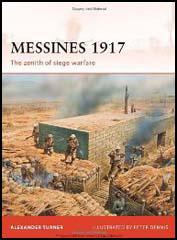
Title: Messines 1917
Author: Alexander Turner
Editor:
Publisher: Osprey
Price: £14.99
Bookshop: Amazon
Spartacus Website: Messines Ridge
Category:
At 0310 hours on 7 June 1917, the pre-dawn gloom on the Western Front was shattered by the 'pillars of fire' - the rapid detonation of 19 huge mines, secreted in tunnels under the German lines and containing 450 tonnes of explosives. Admitted by the Germans to be a 'masterstroke', the devastating blasts caused 10,000 soldiers to later be posted simply as 'missing'. Launching a pre-planned attack into the carnage, supported by tanks and a devastating artillery barrage, the British took the strategic objective of Messines Ridge within hours. A rare example of innovation and success in the First World War, this book is a fresh and timely examination of a fascinating campaign.
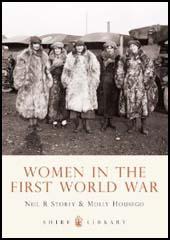
Title: Women in the First World War
Author: Neil Storey & Molly Housego
Editor:
Publisher: Shire Publications
Price: £5.99
Bookshop: Amazon
Spartacus Website: Women and the First World War
Category:
The First World War brought about dramatic changes in the role of women in British society. Suffragettes gave up their militant protests to support the war effort, and from the moment war broke out women were ready to help. As increasing numbers of men left to serve overseas, their duties were taken over by women, who took jobs as postal workers, tram clippies, delivery drivers, land workers and others.
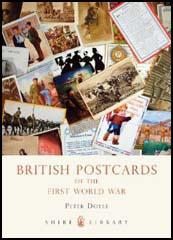
Title: British Postcards of the First World War
Author: Peter Doyle
Editor:
Publisher: Shire Publications
Price: £5.99
Bookshop: Amazon
Spartacus Website: Letters from the Trenches
Category:
Postcards sent by men on the front, and to them by their families, are among the most numerous, and most telling, surviving artefacts of the Great War. They tell us much about attitudes towards the war, and provide a great insight into men’s lives, and into the thoughts and emotions of those left behind. Very different in their illustration, and in their writing, between the beginning of the war and the end, postcards provide a social history of the war in microcosm. Illustrated with a wide range of postcards, this is a fascinating look into the response of the British people to the horrors of the war.
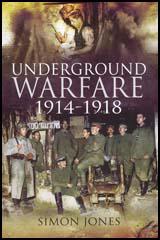
Title: Underground War: 1914-1918
Author: Simon Jones
Editor:
Publisher: Pen & Sword
Price: £25.00
Bookshop: Amazon
Spartacus Website: Tunnelling
Category:
Simon Jones’s graphic history of underground warfare during the Great War uses personal reminiscences to convey the danger and suspense of this unconventional form of conflict. He describes how the underground soldiers of the opposing armies engaged in a ruthless fight for supremacy, covers the tunnelling methods they employed, and shows the increasingly lethal tactics they developed during the war in which military mining reached its apotheosis. He concentrates on the struggle for ascendancy by the British tunnelling companies on the Western Front. They outfought their German adversaries underground, and their efforts climaxed with the detonation of nineteen enormous mines beneath the Messines Ridge in June 1917. But this wide- ranging study also tells the story of the little known but fascinating battles fought in the French sectors of the Western Front which have never been described before in English. Vivid personal testimony is combined with a lucid account of the technical challenges – and ever- present perils – of tunnelling in order to give an all-round insight into the extraordinary experience of this underground war. Simon Jones assesses the impact of these underground battles on the fluctuating fortunes of the opposing armies, and he places them in the longer context of military history from medieval times to the present day.
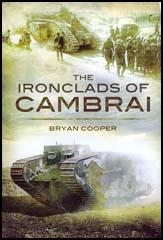
Title: The Ironclads of Cambrai
Author: Bryan Cooper
Editor:
Publisher: Pen & Sword
Price: £19.19
Bookshop: Amazon
Spartacus Website: Cambrai
Category:
When tanks, the newly invented British weapon, were used for the first time in a mass attack on November 20 1917, they not only achieved one of the most remarkable successes of the First World War but set the pattern for the future of mechanised warfare. For the first time in three years of bloody trench warfare, epitomised by the slaughter at Passchendaele which was then reaching its climax, tanks brought about a breakthrough of the massive German defence system of the Hindenburg Line, followed up by British infantry and cavalry divisions. They were supported for the first time by low flying fighter aircraft of the Royal Flying Corps. The initial victory at Cambrai brought cheering crowds into the streets of London and the ringing of church bells in celebration. In seemed possible that the success might bring about the final defeat of Germany. But the British High Command failed to exploit the success. Generals who still dreamt of massive cavalry charges had not had much faith in this strange new weapon that had been brought to them – funded initially by the Royal Navy at the behest of Winston Churchill who was then First Lord of the Admiralty and did see its value. The High Command did not really believe the breakthrough was possible and tragically miscalculated the necessary steps to follow it up. Within days the Germans counter-attacked and regained much of the ground that the British had won. What could have been the final victory was delayed for another year.
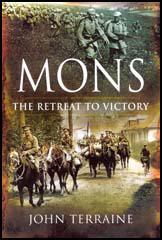
Title: Mons: The Retreat to Victory
Author: John Terraine
Editor:
Publisher: Pen & Sword
Price: £12.99
Bookshop: Amazon
Spartacus Website: Mons
Category:
The Battle of Mons takes its place in the history of the British army beside Corunna and Dunkirk. Initially, all three were defeats, saved from disaster by the courage of the soldiers and the skill of some of the commanders, and paving the way to great feats of arms and final success. In the context of the whole of the WW1, Mons was a small scale affair; comparatively short in duration, and resulting in casualties that were light indeed by the standard of later battles. But, from the British viewpoint, its importance was crucial, partly because it was the first time for close on a hundred years that a British Army had been engaged in warfare on the continent of Europe, and partly because that army passed straight from the dejection of defeat to the exhilaration of the Battle of the Marne – one of the decisive battles of the War.
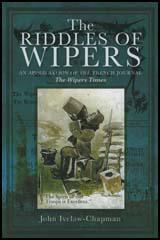
Title: The Riddles of Wipers
Author: John Ivelaw-Chapman
Editor:
Publisher: Pen & Sword
Price: £10.39
Bookshop: Amazon
Spartacus Website: The Soldiers
Category:
The Wipers Times was the Private Eye of the Ypres Salient during WW1. Edited, while under bombardment, by a battalion commander in the Sherwood Foresters, written by soldiers actually in the trenches and distributed by ration-wagon and ammunition-mule. The paper bears vivid witness to the shocking realities of trench warfare. Yet for all the occasional horror of its content, The Wipers Times was a gentle, humour-filled and satirical paper which, once its codes are cracked and its riddles solved, tells an interested reader much about the characters and personalities of the men in the British Army. The Mud, the Gas, the Shells; the Fear, the Courage, the Humour and the Bitterness; much is revealed about these and many other things in this remarkable book.
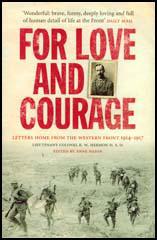
Title: For Love and Courage
Author: E. W. Hermon
Editor:
Publisher: Preface Publishing
Price: £8.99
Bookshop: Amazon
Spartacus Website: Trench War
Category:
Lt Colonel E.W. Hermon died in a hail of bullets on the 9th April 1917, the first day of the Battle of Arras, leading his men of the 24th Battalion Northumberland Fusiliers into the attack. Like hundreds of thousands of others in the Great War, he gave his life for his King and country. He was shot through the heart, one bullet slicing through the papers in his top pocket, including the four-leaf clover his wife had given him for good luck. His final words to his Adjutant were 'Go on!' before he sank to his knees and died almost instantaneously. He was carried from the battlefield by his faithful soldier servant, Buxton, and now lies buried in the Commonwealth War Graves Cemetery at Roclincourt, three miles from Arras. This could have been the end of the story but he left a testament of his life and ideals in a unique and hitherto unknown and unpublished collection of long and detailed letters he wrote to his darling wife and his children, 'the Chugs'. Now, nearly a century after his death, he speaks to us of a past, less cynical life, where selflessness, honor, duty and courage were admired above all else. His own courage was officially recognized as he was mentioned in dispatches three times and posthumously awarded the D.S.O. The letters have been transcribed and edited by Hermon's granddaughter Anne Nason with the guidance and historical advice of James Holland, the distinguished historian and writer. Peter Caddick-Adams, who works alongside Richard Holmes at Cranfield University, believes the letters to be unique in their candour and context since Hermon was Battalion Commander and thus his letters were not censored.
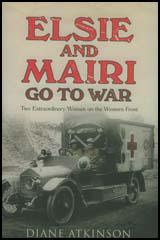
Title: Elsie and Mairi Go to War
Author: Diane Atkinson
Editor:
Publisher: Preface Publishing
Price: £20.00
Bookshop: Amazon
Spartacus Website: Women at War
Category:
When they met at a motorcycle club in 1912, Elsie Knocker was a thirty year-old motorcycling divorcee dressed in bottle-green Dunhill leathers, and Mairi Chisholm was a brilliant eighteen-year old mechanic, living at home borrowing tools from her brother. Little did they know, theirs was to become one of the most extraordinary stories of the First World War. In 1914, they roared off to London 'to do their bit', and within a month they were in the thick of things in Belgium driving ambulances to distant military hospitals. Frustrated by the number of men dying of shock in the back of their vehicles, they set up their own first-aid post on the front line in the village of Pervyse, near Ypres, risking their lives working under sniper fire and heavy bombardment for months at a time. As news of their courage and expertise spread, the 'Angels of Pervyse' became celebrities, visited by journalists and photographers as well as royals and VIPs. Glamorous and influential, they were having the time of their lives, and for four years, Elsie and Mairi and stayed in Pervyse until they were nearly killed by arsenic gas in the spring of 1918. But returning home and adjusting to peacetime life was to prove even more challenging than the war itself.
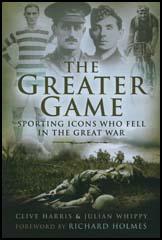
Title: The Greater Game: Sporting Icons Who Fell in the Great War
Author: Clive Harris and Julian Whippy
Editor:
Publisher: Pen & Sword
Price: £19.99
Bookshop: Amazon
Spartacus Website: Sport and the First World War
Category:
Amongst the many thousands of lives tragically cut short in the First World War were hundreds of young men who had athletic and sporting promise. This book studies fourteen professional sportsmen who gave their lives in that most vicious of conflicts. It also looks deeper into the impact that the War had on professional sport in Britain and the raising of sportsman-specific Pals units that enabled a number of these men to serve side-by-side in the trenches of France and Flanders.
Their intriguing yet tragic stories are drawn from the ranks of professional footballers, international rugby stars, Wimbledon champions, Olympic gold medallists, cricketing heroes, golfing professionals, a member of the Ice Hockey Hall of Fame and a Tour de France winner of the countries fighting for the Allied cause.
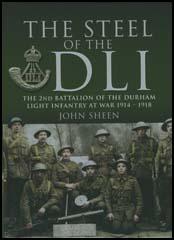
Title: The Steel of the DLI
Author: John Sheen
Editor:
Publisher: Pen & Sword
Price: £20.00
Bookshop: Amazon
Spartacus Website: Western Front
Category:
The 2nd Battalion of the Durham Light Infantry was one of only two battalions of the regiment that did not have its history published in some form after the Great War, the other was the 1/7th (Territorial) Battalion. As the regular Home Service battalion of the regiment it was brought up to strength with Regular Reservists and men from the Special Reserve and went out to France in September 1914, where it fought at the Battle of the Aisne, before moving north to Flanders. The battalion was in action immediately that war was declared on 4th August 1914, when a detachment based at South Shields boarded a German Steamer on the River Tyne and took the crew prisoner and marched them through the town to the Police Station. The book includes material from unpublished letters and diaries of both officers and men and has lots of photographs from the Regimental Archives, a number of which show named officers and men in the trenches around Armentierres in 1915.

Title: The Great Edwardian Naval Feud
Author: Richard Freeman
Editor:
Publisher: Pen & Sword
Price: £20.00
Bookshop: Amazon
Spartacus Website: War at Sea
Category:
This is the story of the clash between two gigantic personalties in the early years of the twentieth century. On one side was Admiral Lord Charles Beresford. Physically strong, courageous and hot-headed, he was the most popular admiral in the navy. Addicted to the sound of his own voice, he drew crowds of thousands whenever he spoke in public. On the other side was the First Sea Lord, Admiral Sir John Fisher. Of humble origin, he had risen through hard work and genius to become the greatest naval reformer that Britain has ever known. Both men wished to be First Sea Lord. When the prize went to Fisher, Beresford determined to unseat him at any cost. He launched attacks in Parliament, he plotted with Unionist politicians, he leaked state secrets and he courted public opinion. As a popular public figure, no one dared act against him until he finally over-stepped the mark and viciously hounded a rear-admiral out of his fleet. A Cabinet inquiry followed, sitting for fifteen days. Its five members listened to Beresford's incoherent account of his eight charges. In the end, they dismissed the charges, but failed to show any warm support for either man. Fisher's resignation followed and Beresford's career came to an end.
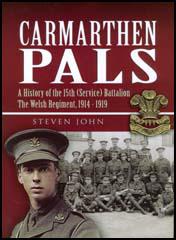
Title: Carmarthen Pals
Author: Steven John
Editor:
Publisher: Pen & Sword
Price: £25.00
Bookshop: Amazon
Spartacus Website: Pals Battalions
Category:
The Carmarthenshire Battalion was one of the early units raised in 1914 as a result of Lord Kitchener's expansion of the regular army by 500,000 men for the duration of the Great War. Lloyd George, then Chancellor of the Exchequer, had a vision of a Welsh Army Group and massive efforts were made to recruit and form Welsh fighting units. The first 200 recruits for the Carmarthen Pals came from Bolton, strangely enough, but later they were mainly drawn from the County and wider Wales. Initial training was at Rhyl. In April 1915 the Battalion became part of 114 Brigade, 38 (Welsh) Division and after completing training and equipping it crossed to France in December 1915. From early 1916 until the Armistice the Carmathen Pals fought with distinction. Initially at Givency, it moved to the Somme in May 1916 and attacked Mametz Wood in the early days of that most terrible July offensive. Thereafter the Battalion moved to the Ypres Salient and in July 1917 attacked Pilckem Ridge. Moves south to Armentieres district, then the Albert Sector followed.
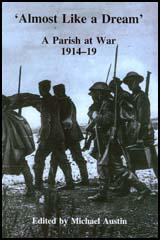
Title: Almost Like a Dream
Author: Michael Austin
Editor:
Publisher: Merton Priory Press
Price: £14.95
Bookshop: Amazon
Spartacus Website: Letters from the Trenches
Category:
Throughout the First World War the vicar of St Michael's in Derby, a largely working-class parish, encouraged men who had joined up to write of their experiences for the parish magazine. The resulting letters form a remarkable record of the hopes and fears, as well as the day-to-day lives, of these men. All volunteers, most served in the ranks of their local county regiment, seeing action on the Western Front, in Greece, Palestine and South Africa. The letters, edited here with an introduction, biographical notes and photographs, bring to life the horrors of the Great War with a stark authenticity that only comes from first-hand accounts. These are not polished literary compositions written for publication by the well-known authors and war poets of the period, most of whom served as officers, but the hasty scribbles, full of fear and emotion, the feelings of ordinary men who fought in the trenches of France and Flanders, suffered the heat and dust of India, or the struggled to survive the disease-ridden campaigns of Salonika and East Africa.
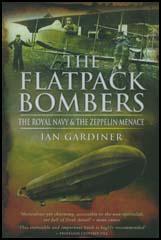
Title: The Flatpack Bombers
Author: Ian Gardiner
Editor:
Publisher: Pen & Sword
Price: £19.99
Bookshop: Amazon
Spartacus Website: Zeppelin Raids
Category:
Our vision of aviation in the First World War is dominated by images of gallant fighter pilots duelling with each other high over the Western Front. But it was the threat of the Zeppelin which spurred the British government into creating the Royal Flying Corps, and it was this 'menace', which no aircraft could match in the air at the beginning of the war, which led Winston Churchill and the Royal Navy to set about bombing these airships on the ground. Thus in 1914, the Royal Naval Air Service, with their IKEA-style flatpack aeroplanes, pioneered strategic bombing. Moreover, through its efforts to extend its striking range in order to destroy Zeppelins in their home bases, the Royal Navy developed the first true aircraft carriers. This book is the story of those largely forgotten very early bombing raids. It explains the military and historical background to the first British interest in military and naval aviation, and why it was that the Navy pursued long distance bombing, while the Army concentrated on reconnaissance. Every bomber raid, and every aircraft carrier strike operation since, owes its genesis to those early naval flyers, and there are ghosts from 1914 which haunt us still today.
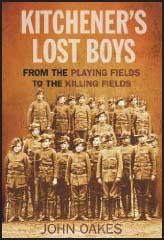
Title: Kitchener's Lost Boys
Author: John Oakes
Editor:
Publisher: History Press
Price: £20.00
Bookshop: Amazon
Spartacus Website: Lord Kitchener
Category:
In the early days of the First World War, Lord Kitchener made his famous appeal for volunteers to join the New Army. Men flocked to recruiting offices to enlist, and on some days tens of thousands of potential soldiers responded to his call. Men had to be at least eighteen years old to join up, and nineteen to serve overseas, but in the flurry of activity many younger boys came to enlist: some were only thirteen or fourteen. Many were turned away, but a lot were illegally signed up, and at least 250,000 under-age boys found themselves fighting for King and Country in the First World War. In this groundbreaking new book, John Oakes delves into the complex history of Britain's youngest Great War recruits. Focusing on a school cricket team, all eleven of whom volunteered, he reveals why boys joined up, what their experiences were and how they survived to endure a lifetime of memories. For those who didn't, an unknown grave awaited. In some cases, their mothers never knew what had become of their children.
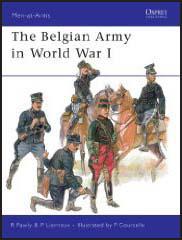
Title: The Belgian Army in World War I
Author: R. Pawly & P. Lierneux
Editor:
Publisher: Osprey
Price: £9.99
Bookshop: Amazon
Spartacus Website: The Belgian Army
Category:
While small in numbers, the Belgian Army played a vital role in World War 2 that is often overlooked. Germany's invasion of neutral Belgium, which led Britain to declare war in August 1914, should have been swift and fierce yet the unexpected heroic defence, against great odds, of Belgian fortresses, frustrated the German Schlieffen Plan for a thrust to Paris and a lightning victory. The plucky Belgian resistance proved successful in buying time for French and British troops to mobilize and report to the front, where the Belgians would then go on to fight, stubbornly defending the northern end of the Allied trench line for the rest of the war. In this work, discover the story of this determined Army, from their organization and commanders, to their uniforms and equipment. The only main combatant army of World War I not previously covered by Osprey, this volume will be an important addition to any enthusiast's collection, accompanied by detailed artwork and archive photographs.
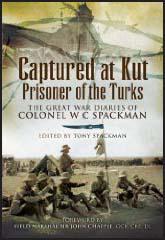
Title: Captured at Kut
Author: W. C. Spackman
Editor:
Publisher: Pen & Sword
Price: £19.99
Bookshop: Amazon
Spartacus Website: Turkish Army
Category:
This edited diary is Colonel Bill Spackman's extraordinary personal record of his experiences as the Medical Officer of an Indian Infantry battalion during the Mesopotamian Campaign 1914 - 1916. In particular he describes the harrowing events of the five month siege of Kut and, after the surrender of the 10,000 strong garrison in April 1916, the hardships of the 1,000 mile forced march to Anatolia in Turkey. As a doctor he witnessed at first hand suffering the and deaths of many POWs, both British and Indian. The book goes on the record life in Turkish captivity which was relatively relaxed and fortunately, in sharp contrast to their earlier experiences.
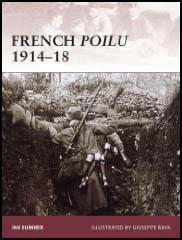
Title: French Poilu 1914-18
Author: Ian Sumner
Editor:
Publisher: Osprey
Price: £11.99
Bookshop: Amazon
Spartacus Website: French Army
Category:
During World War One the French Army was in a state of disarray, plagued by indiscipline, mutinies and desertion. The ordinary French citizens that were called upon to defend their motherland - the Poilu - were disrespected and demoralized, and the infamous mutinies of 1917 by the Poilu were not protests against the war itself, but against how the war was conducted. Ian Sumner expertly charts the history of the Poilu, from the conscription of hundreds of thousands of men, through their training, to the horrors of the trenches and the fear of no man's land. Accompanied by new artwork and diagrams, this book provides a fascinating insight into the experiences of ordinary Frenchman called upon to defend their motherland.
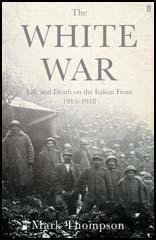
Title: The White War
Author: Mark Thompson
Editor:
Publisher: Faber & Faber
Price: £25.00
Bookshop: Amazon
Spartacus Website: Italy and the First World War
Category:
In May 1915, Italy declared war on the Habsburg Empire, hoping to seize its ‘lost’ territories of Trieste and Tyrol. The result was one of the most hopeless and senseless modern wars - and one that inspired great cruelty and destruction. Nearly three-quarters of a million Italians - and half as many Austro-Hungarian troops - were killed. Most of the deaths occurred on the bare grey hills north of Trieste, and in the snows of the Dolomite Alps. Outsiders who witnessed these battles were awestruck by the difficulty of attacking on such terrain. General Luigi Cadorna, most ruthless of all the Great War commanders, restored the Roman practice of ‘decimation’, executing random members of units that retreated or rebelled. Italy sank into chaos and, eventually, fascism. Its liberal traditions did not recover for a quarter of a century - some would say they have never recovered. Mark Thompson relates this nearly incredible saga with great skill and pathos. Much more than a history of terrible violence, the book tells the whole story of the war: the nationalist frenzy that led up to it, the decisions that shaped it, the poetry it inspired, its haunting landscapes and political intrigues; the personalities of its statesmen and generals; and also the experience of ordinary soldiers - among them some of modern Italy’s greatest writers.
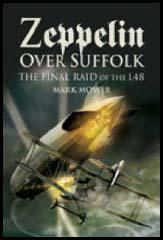
Title: Zeppelin over Suffolk
Author: Mark Mower
Editor:
Publisher: Pen & Sword
Price: £12.99
Bookshop: Amazon
Spartacus Website: Zeppelin Raids
Category:
Zeppelin Over Suffolk tells the remarkable story of the destruction of a German airship over East Anglia in 1917. The drama is set against the backdrop of Germany's aerial bombing campaign on Britain in the First World War, using a terrifying new weapon, the Zeppelin. The course of the raid on that summer night is reconstructed in vivid detail, moment by moment - the Zeppelin's take off from northern Germany, its slow journey across the North Sea, the bombing run along the East Anglian coast, the pursuit by British fighters high over Suffolk, and the airship's final moments as it fell to earth in flames near the village of Theberton in the early morning of 17 June 1917. Mark Mower gives a gripping account of a pivotal episode in the pioneering days of the air war over England.
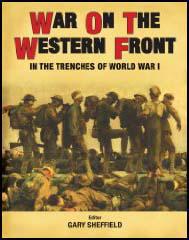
Title: War on the Western Front
Author: Gary Sheffield
Editor:
Publisher: Osprey
Price: £12.99
Bookshop: Amazon
Spartacus Website:
Category:
World War I stands as a watershed in the evolution of modern warfare, with the development of sophisticated trench systems forming a battlefield over 400 miles long, innovations in weaponry and equipment and the introduction of tanks in battle. Without the ordinary soldier, however, there could have been no war: the Great War was very much a conflict of infantrymen - the largely forgotten masses of Tommies, Fritzes, Poilus and Doughboys. With a foreword by renowned World War I historian Gary Sheffield, "War on the Western Front" examines the day-to-day lives of these men as they fought and died in the trenches, from their recruitment and training to combat experience, vividly recounting the shock of life on 'the front'.It also provides an extensive re-assessment of trench warfare, a revolutionary tactic that challenged the very idea of war, and details developments in weaponry and armoured vehicles, including terrifying innovations in the use of poison gas, flamethrowers and tanks.
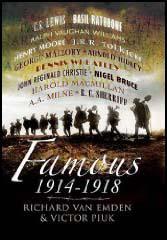
Title: Famous 1914-1918
Author: Richard Van Emden & Victor Piuk
Editor:
Publisher: Pen & Sword
Price: £25.00
Bookshop: Amazon
Spartacus Website: George Mallory
Category:
"Famous" tells the Great War stories of as many as twenty of Britain's most respected, best known and even notorious celebrities. They include politicians, actors, writers, an explorer, a sculptor and even a murderer. The generation that grew up in the late 19th Century enlisted enthusiastically in the defence of the country. Many would become household names such as Basil Rathbone, the definitive Sherlock Holmes, A A Milne, creator of Winnie the Pooh, and Arnold Ridley who found fame and public affection as the gentle and genial Godfrey, in Dad's Army. From politicians such as Harold Macmillan and Winston Churchill to writers including J B Priestley, and J R R Tolkein, from sculptors like Henry Moore, to composers such as Ralph Vaughan Williams, their fame and influence continue even into the 21st Century. The authors Richard van Emden and Vic Piuk have discovered the exact locations where these celebrities saw action. They tell the story of how J R R Tolkein led his men over the top on the Somme, where C S Lewis was wounded and invalided home, and how Basil Rathbone won the Military Cross for a trench raid (while dressed as a tree).
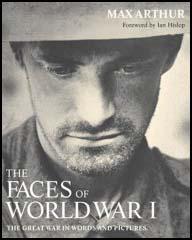
Title: The Faces of World War I
Author: Max Arthur
Editor:
Publisher: Octopus
Price: £25.00
Bookshop: Amazon
Spartacus Website: Chronology of First World War
Category:
In "The Faces of World War I" Max Arthur has delved into the superb photographic archives of the Imperial War Museum and other important collections to unearth remarkable, never before seen images that, when married with his contemporary eye-witness accounts, truly bring a unique perspective to the First World War. "The Faces of World War I" charts the changes that took place in Edwardian Britain and continental Europe following the assassination of the Archduke Franz Ferdinand in 1914 that led to the outbreak of war. It paints a startling portrait of the recruitment and militarization of an entire generation of young men, beginning with the British Expeditionary Forces entry into warfare in 1914. Max Arthur tells the story in words and pictures of this newly conscripted army through their five years of slaughter and suffering. As well as the British troops and civilians, we also see pictures of German troops and their own suffering, in a journey that follows the armies right through to their return home or, in some cases, their tragic end on the battlefield. This photographic milestone brilliantly conveys not only the heroism, but also the universal horror, futility, humour and boredom of warfare. From the front-line troops and their daily dice with death, to the support lines, communications, enlistment, training and propaganda. Every aspect of the soldiers life is covered here, in this brilliant collection of images that brings the Great War to life in a way never done before.
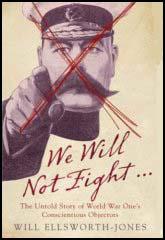
Title: We Will Not Fight
Author: Will Ellsworth-Jones
Editor:
Publisher: Aurum Press
Price: £18.99
Bookshop: Amazon
Spartacus Website: No Conscription Fellowship
Category:
In June 1916 Philip Brocklesby, a young second lieutenant just arrived in Boulogne, slipped away from his regiment in a desperate attempt to see his brother who had been imprisoned nearby. But it wasn't the enemy who were holding Bert, but his own army. Bert, along with 34 other conscientious objectors, had been court marshalled for refusing to fight, and was waiting to hear if he would be sentenced to death. The meeting was happy and affectionate, but then both brothers knew it may be their last.Through the amazing story of the Brocklesby family, Will Ellsworth-Jones explores the history of conscientious objection in World War I, charting the experiences of the men who took a stand despite being stigmatised, vilified and facing death. This amazing book also considers the men's lasting legacy. Without the courage of men such as Bert who were prepared to die for their beliefs, we wouldn't have the freedom to voice our beliefs and protest at our government's involvement in conflict. At the end of this touching book, the reader will ask themselves whether they would have had the courage to fight in the trenches, but more importantly whether they would have had the courage not to fight. Packed with unpublished letters, diaries, memoir extracts and oral interviews, "We Will Not Fight" is a fascinating look at conscientious objection in WWI, and its legacy.It explores Conscientious Objection in WWI through an extraordinary personal story of two British brothers - one who was prepared to die fighting; the other who was prepared to die refusing to fight. It contains well-researched and intensely moving history full of unpublished diaries, letters, trial notes and memoir extracts. Offering a unique perspective on an ever popular period of history, especially in light of recent protest over Iraq, this book is ideal for review and media coverage.
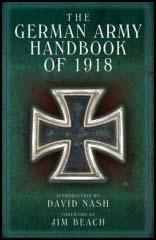
Title: The German Army Handbook of 1918
Author: Deryck Schreuder
Editor:
Publisher: Frontline Books
Price: £19.99
Bookshop: Amazon
Spartacus Website: German Army
Category:
Compiled by British Intelligence, for restricted official issue by the General Staff, "German Army Handbook", April 1918, is a comprehensive assessment of the German Army during the latter stages of the First World War. Illustrated throughout with plates, diagrams, charts, tables and maps, it provides a detailed breakdown of the army, covering all aspects from recruiting and training, mobilization, command and organisation, weapons and signals to transportation, medical and veterinary services, and uniform. There are also two maps, showing Army Corps Districts, and Zones of Administration and Lines of Command in June 1917.The events of 1914 transformed the armies of Europe, and made much of the information contained in the amended 1912 handbook worthless. The emergence of trench warfare created conditions in which the traditional concepts of offence and defence had little meaning. Within a few months battle conditions had created a situation in which pre-war intelligence publications had only little relevance. "The German Army Handbook", April 1918 was a remarkable achievement. It provides solutions to many questions that histories of the First World War and accounts of its battles are unable to answer. It shows how the static conventions of trench warfare usurped the traditional role of cavalry, and how the German Army were able to take advantage of the dominance of the machine-gun on the Western Front in 1915.
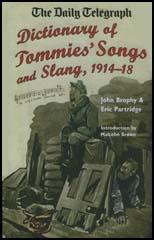
Title: Dictionery of Tommies' Songs and Slang
Author: John Brophy & Eric Partridge
Editor:
Publisher: Frontline Books
Price: £19.99
Bookshop: Amazon
Spartacus Website: Soldiers
Category:
During the First World War the British soldiers were renowned for their chirpy songs and plucky sayings. Indeed nothing would lift the spirits of the often exhausted and demoralized troops more than a hearty singalong. These cheery and at times ribald and satiric songs and sayings have been collected together to give a fascinating insight into the more light-hearted side of trench life. The songs include marching tunes, songs for billets and rude chants for when no commanding officer was present. Each song is accompanied by a short passage that traces the origins of the melody and accounts for lyrical alternatives. There is also a large glossary of soldiers' slang words and phrases, revealing the Tommies' vocabulary in all its bawdiness. "The Daily Telegraph - Dictionary of Tommies' Song and Slang" reveals the courage, gaiety and astringent cynicism with which men armed themselves against the horrors of trench warfare.
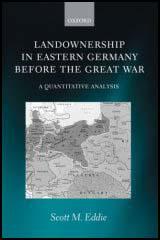
Title: Landownership in Eastern Germany Before the Great War
Author: Scott M. Eddie
Editor:
Publisher: Oxford University Press
Price: £65.00
Bookshop: Amazon
Spartacus Website:
Category:
The big landlords of eastern Germany have loomed large in the country's history, but the absence of official statistics on landownership has left their position and identity confined to folklore, without satisfactory quantification. This study, making extensive use of primary sources from the seven 'core provinces' of eastern Germany-the so-called 'East Elbian' region-establishes answers to questions pivotal to our understanding of pre-war Germany: who were the biggest landowners, both by area and by the tax assessment of their land? Which social groups held land? How much land did they own and where? How did this change, especially during the last decades before the Great War? Professor Eddie demonstrates that most of the inroads into landownership by the bourgeoisie had already been made by the mid-1850s, perhaps even before the mid-1830s. However, one of the most interesting findings in this study is that, despite rapid industrialization after 1880, there was a net exodus of the nouveaux riches from the ranks of large land owners. On the eve of war, the largest landowners were the Prussian state, the royalty, and the higher nobility. Meticulously researched and thoroughly documented, this book will be the benchmark for all future work in this area.
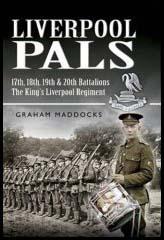
Title: Liverpool Pals
Author: Graham Maddocks
Editor:
Publisher: Pen & Sword
Price: £25.00
Bookshop: Amazon
Spartacus Website:
Category:
"Liverpool Pals", is a record of duty, courage and endeavour of a group of men who, before war broke out in 1914, were the backbone of Liverpool's commerce. Fired with patriotism, over 4,000 of these businessmen volunteered in 1914 and were formed into the 17th, 18th, 19th and 20th (Service) Battalions of the King's (Liverpool Regiment); they were the first of all the Pals battalions to be raised, and they were the last to be stood down.It is commonly held that the North of England's Pals battalions were wiped out on the 1st July, 1916, certainly this befell a number of units, but the Liverpool Pals took all their objectives on that day. From then on they fought all through the Somme Battle, The Battle of Arras and the muddy hell of Passchendaele in 1917, and the desperate defence against the German offensive of March 1918.
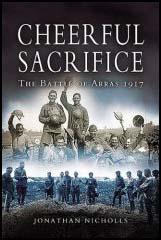
Title: Cheerful Sacrifice
Author: Joanthan Nicholls
Editor:
Publisher: Pen & Sword
Price: £14.99
Bookshop: Amazon
Spartacus Website:
Category:
Cheerful Sacrifice tells the story of the spring offensive of April - May 1917, otherwise known as the Battle of Arras. Probably because the noise had hardly died down before it started up again with the explosions at Messines, shortly to be followed by the even more horrible Third Ypres - remembered as Passchendaele - the Battle of Arras has not received the attention it deserves. Yet, as the author points out, on the basis of the daily casualty rate it was the most lethal and costly British offensive battle of the First World War. In the thirty-nine days that the battle lasted the average casualty rate was far higher than at either the Somme or Passchendaele. Jonathan Nicholls, in this his first book, gives the Battle of Arras its proper place in the annals of military history, enhancing his text with a wealth of eye-witness accounts. One is left in no doubt that the survivor who described it as 'the most savage infantry battle of the war', did not exaggerate. Nor can there be much doubt that the author is destined to rise high in the firmament of military historians.
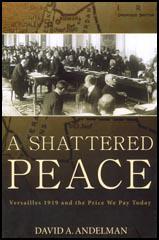
Title: A Shattered Peace: Versailles 1919
Author: David A. Andelman
Editor:
Publisher: Wiley
Price: £30.00
Bookshop: Amazon
Spartacus Website: Versailles Treaty
Category:
In a Shattered Peace, veteran foreign correspondent David A. Andelman takes a fresh look at the Treat of Versailles as the point of origin for many of today's most critical international issues. This revealing history exposes the powerful lessons that a six-month period in a long ago era has for us today. Andelman turns the spotlight on the many errors committed by the peacemakers that led to crises and bloodshed from Algeria to Kosovo and wars from Israel to Vietnam.
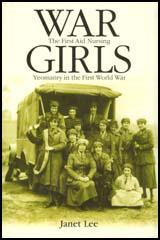
Title: War Girls
Author: Janet Lee
Editor:
Publisher: Manchester University Press
Price: £30.00
Bookshop: Amazon
Spartacus Website: First Aid Nursing Yeomanry
Category:
The fascinating story of the British women who volunteered for service in the First Aid Nursing Yeomanry during the First World War; Accessible and enjoyable to read history of an interesting, quirky, audacious and pioneering sisterhood of women; Analyses the relationship between gender and war in the early twentieth century; The first full length book on the subject; The author's passion and enthusiasm for her subject are palpable; Includes personal testimonies e.g. diaries, letters and memoirs from the women themselves.
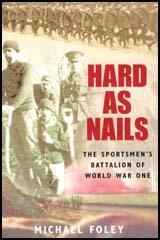
Title: Hard as Nails
Author: Michael Foley
Editor:
Publisher: Spellmount
Price: £18.99
Bookshop: Amazon
Spartacus Website: Sport and the First World War
Category:
This is the history of the Sportsmen's Battalion, Royal Fusiliers 23rd service battalion, which consisted almost entirely of men from the world of sport or entertainment. The battalion was privately raised and took men up to the age of 45. The battalion included a champion boxer, cricketers, footballers, MPs and the author John Chessire. They were men who did not need to serve in the First World War but had an unquestioning sense of duty. The history is enhanced by the letters and drawings by John Chessire, giving a first-hand account of their experiences. A man from the upper classes, a writer, poet and artist, he chose to serve as a private so he could do his duty, even when it conflicted with his religious beliefs and love for his family. The book covers the battalion's beginnings in London and progression to Hornchurch, France and then Germany. It includes their time at Vimy Ridge, at the Somme and at the Battle for Deville Wood.
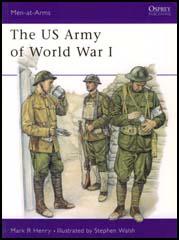
Title: The US Army of World War I
Author: Mark R. Henry
Editor:
Publisher: Osprey
Price: £9.50
Bookshop: Amazon
Spartacus Website: US Army in the First World War
Category:
Before the mid-1916 National Defense Act the US Army had a few tens of thousands of men, but by November 1918 there were nearly a million and a half American combat troops in France. General Pershing's American Expeditionary Force arrived in 1917 short of weapons, equipment, and experience of modern warfare; but it proved itself in the fighting on the Argonne, and played a major part in stopping Germany's last offensive in spring 1918, and in the final advance through the Hindenburg Line. This book details the organisation, uniforms, equipment and campaigns of the US Army in World War I.
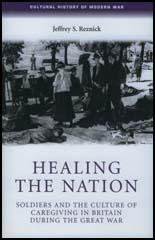
Title: Healing the Nation
Author: Jeffrey S. Reznick
Editor:
Publisher: Manchester University Press
Price: £35.00
Bookshop: Amazon
Spartacus Website: Women and the First World War
Category:
Healing the Nation is a study of caregiving during the Great War, looking anew at life behind the lines for ordinary British soldiers who served on the Western Front. Using a variety of literary, artistic, and architectural evidence, this study draws connections between the war machine and the wartime culture of caregiving: the product of medical knowledge and procedure, social relationships, matériel, institutions and physical environments that informed experiences of rest, recovery and rehabilitation in sites administered by military and voluntary-aid authorities. Rest huts, hospitals, and rehabilitation centers served not only as means to sustain manpower and support for the war but also as distinctive sites where soldiers, their caregivers and the public attempted to make sense of the conflict, and the unprecedented change it wrought, within traditional frames of reference. Revealing many aspects of wartime life that have received limited, if any attention, including the phenomenon of rest huts as ‘homes away from home’ and the notion of ‘convalescent blues’, this study shows that Britain’s ‘generation of 1914’ was a group bound as much by comradeship of healing as by comradeship of the trenches.
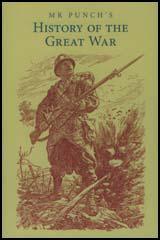
Title: History of the Great War
Author: Punch Magazine
Editor:
Publisher: Nonsuch
Price: £16.00
Bookshop: Amazon
Spartacus Website:
Category:
This is no formal history of the Great War in the strict or scientific sense of the phase; no detailed record of naval and military operations. There have been many occasions on which silence or reticence seemed the only way to maintain the national composure. "Mr Punch's History of the Great War" is a mirror of varying moods, month by month, but also reflecting in the main how England remained steadfastly true to her best traditions.
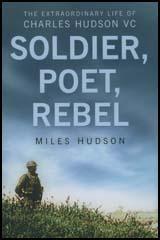
Title: Soldier, Poet, Rebel
Author: Miles Hudson
Editor:
Publisher: Sutton
Price: £19.99
Bookshop: Amazon
Spartacus Website: First World War Soldiers
Category:
Charles Hudson VC was one of the twentieth century's outstanding fighting soldiers. His military career through two world wars and in Russia in 1919 earned him a host of medals. He was also a man of deep feeling, an accomplished poet and, in many ways, a rebel. In this compelling biography, the author skilfully interweaves his own narrative insight with his father's wartime journals and other unpublished material. The narrative includes detailed personal descriptions of the Battle of the Somme and other actions. It recounts the authoress Vera Brittain's bitter reaction to the death of her brother Edward when under Hudson's command in Italy in 1918 and tells how Hudson, out of compassion for her feelings, did not reveal the truth until he met her in 1934. It tells of the extraordinary affair in the summer of 1940, when the Secretary of State for War, Anthony Eden, asked a meeting of senior army commanders in the then beleaguered Britain whether, in the event of a successful German invasion, their soldiers would agree to be evacuated to Canada or whether they would insist on going home to support their families. The author examines Hudson's motivation in both wars and delves deeply into his complex, and highly courageous, character.
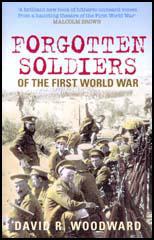
Title: Forgotten Soldiers of the First World War
Author: David Woodward
Editor:
Publisher: Tempus
Price: £12.99
Bookshop: Amazon
Spartacus Website: First World War Battles
Category:
We know a great deal about Lawrence of Arabia but what about the lot of the common soldier who fought on the Middle Eastern Front? Using personal accounts from the diaries and letters of British soldiers who served in the First World War, David Woodward describes the experience of combat in Egypt and Palestine. Drawing upon unpublished records in the Imperial War Museum, "Forgotten Soldiers of the First World War" paints a vivid picture of life for the British Tommy in conditions vastly different from the Western Front, where heat, sand storms and insects proved just as deadly as the enemy.
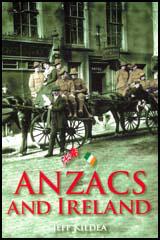
Title: Anzacs and Ireland
Author: Jeff Kildea
Editor:
Publisher: Cork University Press
Price: £19.95
Bookshop: Amazon
Spartacus Website: Allied Forces
Category:
The book offers an account of the activities of Australian soldiers on leave who ended up in Ireland as tourists and often found themselves caught up in the Easter Rising of 1916 and the Black and Tan War. The chapter on the Easter Rising adds a new dimension to the increasingly complex picture of that event, while students and scholars of the Irish diaspora will find much of interest also. The author makes use of participants' diaries. There are fascinating glimpses of rarely mentioned social aspects of wartime Ireland, such as the 'six bob a day tourists' (Australian soldiers on leave). Kildea also looks at the ongoing impact of the First World War on Australian and Irish identity, and compares recent commemorations of WWI in both countries.
